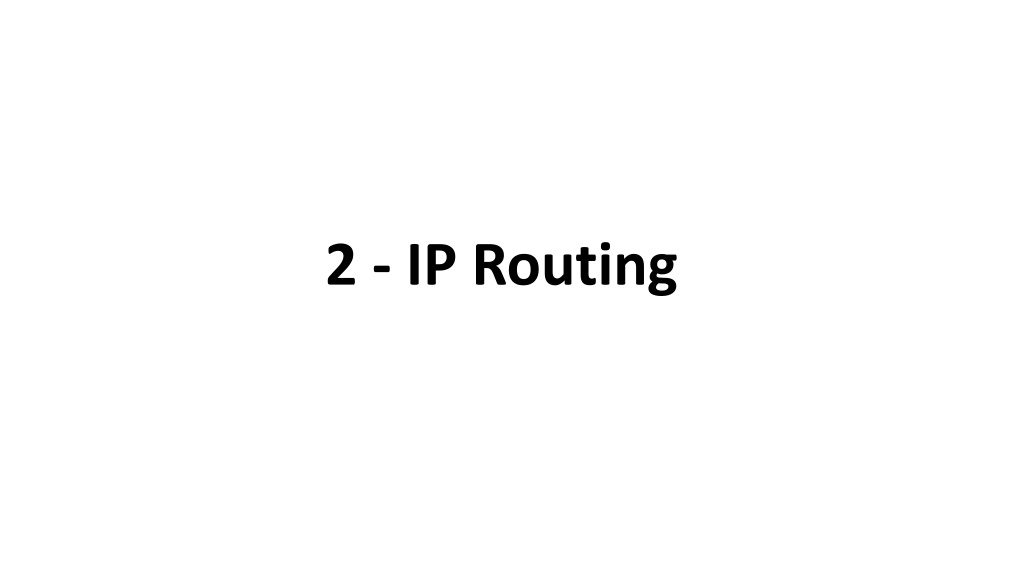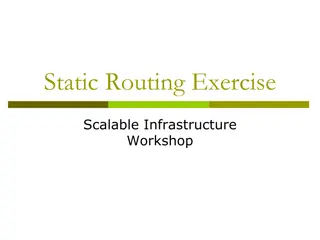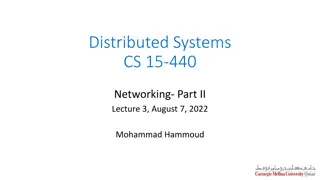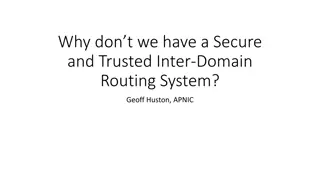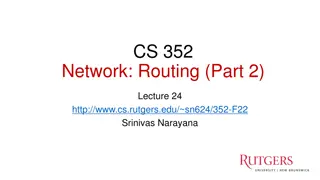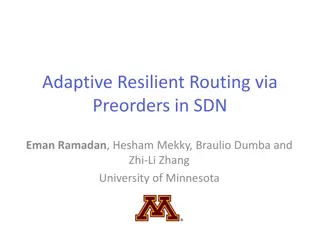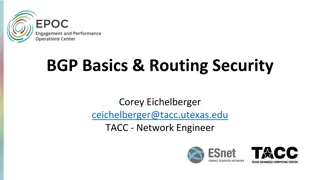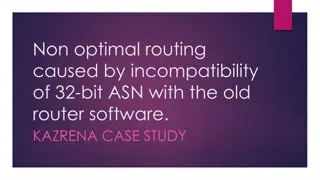Understanding IP Routing and Switching in Computer Networks
In the world of computer networking, IP routing and switching play crucial roles in ensuring efficient data transmission. Switches make decisions based on MAC addresses, while routers route based on IP information. By managing routing tables and using static or dynamic routing protocols, networks can efficiently direct data packets to their intended destinations without the need for extensive MAC address tables. This overview explains the difference between switches and routers, the benefits of IP routing, and how routers facilitate communication between networks.
Download Presentation

Please find below an Image/Link to download the presentation.
The content on the website is provided AS IS for your information and personal use only. It may not be sold, licensed, or shared on other websites without obtaining consent from the author. Download presentation by click this link. If you encounter any issues during the download, it is possible that the publisher has removed the file from their server.
E N D
Presentation Transcript
Switch VS Router: switches based on MAC address information. The only concern for our switch is to know when an Ethernet frame enters one of its interfaces where it should send this Ethernet frame by looking at the destination MAC address. Switches make decisions based on Data Link layer information (layer 2). Routers have a similar task but this time we are going to look at IP packets and as you might recall IP is on the Network layer (layer 3). Routers look at the destination IP address in an IP packet and send it out the correct interface.
We have two switches and to each switch are 200 computers connected. Now if all 400 computers want to communicate with each switch has to learn 400 MAC addresses. The need to know the MAC addresses of the computers on the left and right side. Now think about a really large network for example the Internet. There are millions of devices! Would it be possible to have millions of entries in your MAC-address table? For each device on the Internet? No way!
What we have here is our 200 computers on the left are connected to router A and in the 192.168.1.0 /24 network. Router B has 200 computers behind it and the network we use over there is 192.168.2.0 /24. Routers route based on IP information, in our example Router A only has to know that network 192.168.2.0 /24 is behind Router B. Router B only needs to know that the 192.168.1.0 /24 network is behind Router A. Instead of having a MAC-address-table with 400 MAC addresses we now only need a single entry on each router for each other's networks.
Whenever ComputerA wants to send something to ComputerB this will happen: 1. ComputerA sends an IP packet with destination IP address 192.168.2.2. 2. ComputerA checks its own IP address and subnet mask and concludes that 192.168.2.2 is in another subnet. As a result it will forward the IP packet to its default gateway. 3. The router receives the IP packet, checks the destination IP address and scans the routing table. IP address 192.168.2.2 matches the 192.168.2.0 /24 entry and the router will forward the IP packet out if its FastEthernet 1/0 interface. 4. ComputerB receives the IP packet and life is good!
Now the big question ishow do router Spade and router Hearts know that there is a network behind each other? There are 2 ways how they can learn this information: Static Routing Dynamic Routing If you use static routing you will have to do everything by yourself. YOU tell the router where to send IP packets for a certain network, this might be entertaining but it's a lot of work. Dynamic routing means we use a routing protocol that will exchange network information between routers. Let's start with a configuration example of static routes on some real routers:
Static Routing: We want to make sure that the headquarters can reach the 2.2.2.0 /24 network.
Static Routing: 1- First I'll go to enable mode and enter configuration mode. 2- Then I'll configure the IP addresses on the interfaces; don't forget to do a no shutdown on the interfaces. Headquarters>enable Headquarters#configure terminal First I ll go to enable mode and enter configuration mode. Headquarters(config)#interface FastEthernet 0/0 Headquarters(config-if)#no shutdown Headquarters(config-if)#ip address 192.168.12.1 255.255.255.0 Branch>enable Branch#configure terminal Branch(config)#interface fastEthernet0/0 Branch(config-if)#no shutdown Branch(config-if)#ip address 192.168.12.2 255.255.255.0 Branch(config-if)#exit Branch(config)#interface fastEthernet 1/0 Branch(config-if)#no shutdown Branch(config-if)#ip address 2.2.2.2 255.255.255.0
Use the show ip route command to view the routing table. This is what a router uses to make decisions where to forward IP packets to. By default a router only knows its directly connected networks. We configured an IP address with a subnet mask on the interface so the router also knows the network address. Router Headquarters knows about network 192.168.12.0/24. Router Branch knows about network 192.168.12.0/24 and 2.2.2.0/24. At this moment our Headquarters router has no idea how to reach network 2.2.2.0/24 because there is no entry in the routing table. What will happen when we try to reach it?
Static Routing: Let's use a static route to tell router Headquarters how to reach this network! We use the ip route command to create a static route. Let me break it down for you: 2.2.2.0 is the network we want to reach. 255.255.255.0 is the subnet mask of the network. 192.168.12.2 is called the next hop IP address. It's the IP address where we want to send traffic to. In this example that's the branch router. I'm telling router Headquarters that it can reach network 2.2.2.0 /24 by sending traffic to IP address 192.168.12.2 (the Branch router).
Default Route: the picture above our Headquarters router is connected to an ISP (Internet Service Provider). There are many networks on the Internet so do we require all of those networks on the Internet in our routing table? The answer is no because we can use a default route, let me show you what it is: Let me explain this one: The first 0.0.0.0 is the network address; in this case it means all networks. The second 0.0.0.0 is the subnet mask; all 0s means all subnet masks. 1.2.3.1 is the next hop IP address. In this case the IP address of the ISP router.
Home Work 4: note: all subnet mask is: 255.255.255.0
